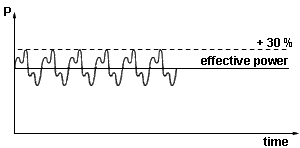Safety factors
The width of a timing belt is correct when the permissible values for tooth shear strength, tension cord strength and flexibility are not exceeded under unfavourable operating conditions. In our catalog, load limits are stated which have been reliably proven and confirmed by bench tests and results obtained in practice.
The important aspect is that the unfavourable load types occurring in the transmission are known or have been correctly assessed by the engineering personnel. With a positive fit transmission, even short-period overloads act via the timing belt being the drive member. Useful information:
Rated operation
Design the timing belt for the rated load operating condition. The rated load is the operating condition at which the transmission is to transmit the torque or the power at rated speeds under normal conditions.
Start-up characteristics
a) Drive side: The max. torque of the drive machine under start-up conditions is to be taken into consideration. The start-up torque, e.g. for three-phase squirrel cage motors amounts to 2 to 2.5 times the rated value.
b) On the drive side: Under start-up characteristics "initial torques" might be taken into account which act on the timing belt as the driving member.
check load case a) or b) at rotational speed n=0.
Brakes
It might have to be defined whether braking leads to loads which fully act via the timing belt and possibly exceed the type of load produced by the rated operation or the start-up characteristics. In the braking operation the torque reversal is to be taken into consideration.
Unevennesses (variations, impact shocks)
In addition to the rated load, superimposed vibration and impact shocks could act on the timing belt as the transmission member. For the illustrated example, increase the calculated belt width by the factor of 1.3.

Moments of inertia
Moments of inertia and/or centrifugal masses in the drives generally create a uniform running behaviour. Depending on the acceleration and deceleration characteristic it has to be differentiated and checked whether the moments of inertia create an additional load on the timing belt.
Step-up transmissions
The following safety factors are to be applied for step-up transmissions:
i = 0,66 to 1,00 ...... S = 1,1
i = 0,40 to 0,66 ...... S = 1,2
i < 0,40 ...................... S = 1,3
In the braking operation may occur a torque reversal and the reduction can change into a step-up transmission.